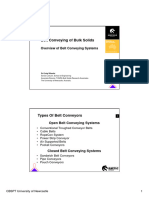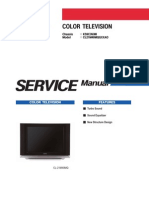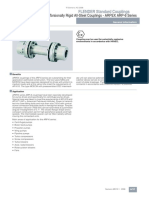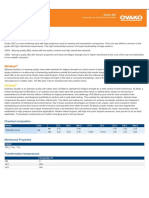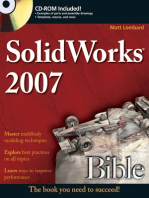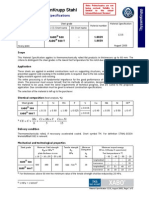Ficha Técnica - XABO 500 - Thyssenkrupp
Ficha Técnica - XABO 500 - Thyssenkrupp
Uploaded by
Diego Ramírez ParraCopyright:
Available Formats
Ficha Técnica - XABO 500 - Thyssenkrupp
Ficha Técnica - XABO 500 - Thyssenkrupp
Uploaded by
Diego Ramírez ParraOriginal Description:
Copyright
Available Formats
Share this document
Did you find this document useful?
Is this content inappropriate?
Copyright:
Available Formats
Ficha Técnica - XABO 500 - Thyssenkrupp
Ficha Técnica - XABO 500 - Thyssenkrupp
Uploaded by
Diego Ramírez ParraCopyright:
Available Formats
Note: Prints/copies are not
being revised. Validity is limited
to the actual Intranet/Internet-
Version!
ThyssenKrupp Steel Europe
Thermomechanically Steel grade Material Specification
Material No.
rolled special TKSE-Short name EN-Short name
structural steels
1215
®
XABO 500 - 1.8829
®
XABO 500 T - 1.8839
Heavy plate November 2010
Scope
This Material Specification applies to thermomechanically rolled flat products in thicknesses up to 60 mm. The
criteria to distinguish the steel grades is the lowest test temperature for the notch-bar impact test.
Application
These steels are applied in welded constructions such as supporting structures, vessels etc., where a secured
prevention against cold cracking in the welded joints is required. Due to the low carbon equivalent, these steels are
highly resistant against cold cracking.
The entire processing is of fundamental importance for the good performance of the products made of these
steels. The processor must assure himself, that his methods of calculation, designing and working conform with
the material to be used, meet the latest requirements of technical progress, and are suited to the proposed
application. Due consideration must be given to relevant construction specifications.
The selection of the material is left up to the purchaser.
Chemical composition (heat analysis, %)
Steel grade C Si Mn P S Cu Nb Ni CE 1)
® ≤ 0.015
XABO 500
≤ 0.15 ≤ 0.60 ≤ 1.80 ≤ 0.025 ≤ 0.40 ≤ 0.05 ≤ 0.50 ≤ 0.47
® ≤ 0.010
XABO 500 T
Mn Cr + Mo + V Cu + Ni
1)
CE = C + + +
6 5 15
Delivery condition
Thermomechanically rolled, if necessary accelerated cooled (short symbol TM) or quenched and tempered (short
symbol QT). For definition STAHL-EISEN-Werkstoffblatt 082 is relevant.
Mechanical and technological properties
Steel grade Minimum Yield strength Tensile strength Minimum Minimum impact energy
ReH, MPa 2) Rm Elongation KV in J (Charpy V-specimens)
plate thickness, mm MPa A5 Test temperature, °C
≤ 16 > 16 ≤ 35 > 35 ≤ 60 % - 50 - 40 - 30 - 20
® longitudinal - - - 40
XABO 500
transverse - - - 20
500 480 460 560 - 720 3) 16
® longitudinal 27 31 40 47
XABO 500 T
transverse 16 20 23 27
3)
For thicknesses above 50 mm the minimum value of the tensile strength shall be reduced by 20 MPa.
_____________________
2)
1 MPa = 1 N/mm2
Material Specification 1215, November 2010, Page 1 of 3
ThyssenKrupp Steel Europe Material Specifications
The values of strength and elongation given in the table before are valid both for transverse specimens.
If the notch-bar-impact test is required, the test temperature and the specimen direction have to be specified in
the order. If no mention is made in the order, the notch-bar impact test will be carried out at the lowest test
temperature given in the table on Charpy V-specimens taken in the longitudinal direction. The values stated for
the impact energy are minimum values obtained as the average of 3 specimens, with no single value being less
than 70 % of the specified values stated in the table.
If the thickness of the material is not sufficient for manufacturing of Charpy V-specimens with a width of 10 mm,
the impact energy value is reduced proportionally to the specimen width (product thickness). No impact test is
performed on products below 5 mm in thickness.
Upon special agreement is made for carrying out a bend test, it will be carried out on transverse specimens, the
mandrel diameter being a minimum of 4 times the material thickness and a bending angle of 180 °.
Physical properties at room temperature (auxiliary values)
Density Modulus of Thermal Mean specific Actual specific Thermal Specific Magnetic
elasticity conductivity heat capacity heat capacity diffusivity electric properties
(dynamic) (20 °C) resistance
W J J
kg/dm3 GPa m K g K g K cm2/s µΩ m
7.85 213 45 0.45 0.45 0.13 0.3 magnetizable
Number of tests
Unless otherwise agreed upon in the order, the tests listed below will be performed during the acceptance
inspection
inspection lot: mother plate 1 test-specimen from one end
From every test piece one tensile test on a transverse specimen at room temperature as well as one notch-bar-
impact test at a temperature specified for the particular steel grade on longitudinal specimens will be carried out.
For tensile tests flat specimens are utilised. At material thicknesses ≤ 40 mm both surfaces as rolled of the
specimens have to be left in their original condition. Flat specimens made of products > 40 mm in thickness shall
be tested either with as rolled surfaces in the case of full-thickness specimens or with the half of the plate
thickness. In this case one as rolled surface remains undisturbed.
Round tensile specimens only are allowed at plate-thicknesses > 30 mm and prior agreement. These test
specimens shall be taken in such a way that their axis lies approximately to ¼ of the plate thickness measured
from the surface of the plate or as close to it as possible.
Notch-bar-impact specimens are taken from an area close to the surface. At plate thicknesses above 40 mm the
specimens are taken in such a way that their longitudinal axis lies approximately to ¼ of the plate thickness
measured from the surface of the plate or as close to it as possible.
Upon special agreement a bend test based on ISO 7438 can be performed. At thicknesses above 25 mm the test
specimen will be machined to 25 mm in thickness.
Fabrication - welding
Products made of steel grades according to this specification
¾ are very suitable for welding. Due to the low tendency for cold cracking, generally at lower plate thicknesses,
preheating prior to welding is not necessary. More over for the fabrication the document "STAHL-EISEN-
Werkstoffblatt 088" has to be applied as well.
Recommendations for welding are also given in EN 1011 part 1 and part 2 - Welding, Recommendation for
welding of metallic materials -.
¾ are very suitable for cold forming and machining.
¾ are not suitable for heat treatment above 580 °C.
Material Specification 1215, November 2010, Page 2 of 3
ThyssenKrupp Steel Europe Material Specifications
General information
Unless otherwise stated in this Material Specification, the delivery will be governed by the conditions outlined in EN
10021. As per prior agreement at the time of ordering other inland and foreign delivery conditions are negotiable.
If special deformation properties vertical to product surface are required, for the steels relating to this Specification
values for the reduction of area in the through-thickness direction may be agreed in the order in accordance with
the three categories of EN 10164 - Steel products with improved deformation properties perpendicular to the
surface of the product.
Ultrasonic examination for internal imperfections can be agreed upon according to EN 10160 - Ultrasonic testing of
steel flat product of thickness equal to or greater than 6 mm (reflection method) -.
Publisher’s addresses
STAHL-EISEN-Werkstoffblätter Verlag Stahleisen GmbH, Postfach 10 51 64, D-40042 Düsseldorf
EN-, ISO Standards Beuth Verlag GmbH, Postfach, D-10772 Berlin
Material Specification 1215, November 2010, Page 3 of 3
You might also like
- 5 Presentacion Jack Wallace - Good Year (Modo de Compatibilidad)Document20 pages5 Presentacion Jack Wallace - Good Year (Modo de Compatibilidad)Juan Manuel Mamani QuispeNo ratings yet
- Data Sheets FajasDocument12 pagesData Sheets FajasGonzalo Rosales JuarezNo ratings yet
- Internet BIS ReportDocument64 pagesInternet BIS Reporthaathinath010% (1)
- CV 01 Shaft Report Drive P5Document2 pagesCV 01 Shaft Report Drive P5Waris La Joi WakatobiNo ratings yet
- Lecture 2 - Belt Conveying - Overview of Belt Conveying SystemsDocument34 pagesLecture 2 - Belt Conveying - Overview of Belt Conveying SystemsNaseerah OsmanNo ratings yet
- Gantrex Raillok Bg20 Data Sheet ImperialDocument2 pagesGantrex Raillok Bg20 Data Sheet Imperialjhon jairo arangoNo ratings yet
- Lorbrand Idler Catalogue Reduced SizeDocument88 pagesLorbrand Idler Catalogue Reduced SizemaiquelernNo ratings yet
- MilHdbk470A - MaintainabilityDocument719 pagesMilHdbk470A - MaintainabilityAndrewNo ratings yet
- Fire Protection Standard For Use of Plastic PipesDocument6 pagesFire Protection Standard For Use of Plastic Pipesjonodo89No ratings yet
- Caixas Rolamentos UsaDocument52 pagesCaixas Rolamentos Usakrlos_SW2009No ratings yet
- Design of Conveyor BeltDocument10 pagesDesign of Conveyor Beltmuhd.qasim100% (1)
- AFBMA Bearing InterchangeDocument1 pageAFBMA Bearing InterchangevandoNo ratings yet
- T11M408 I1 Takraf 03910 Vdcme02 P1me01 004Document42 pagesT11M408 I1 Takraf 03910 Vdcme02 P1me01 004manuelarranoNo ratings yet
- Normas Sistemas de Transmicion de PotenciaDocument10 pagesNormas Sistemas de Transmicion de PotenciaCristian Gonzalez ThomasNo ratings yet
- Iso 657-5-1976Document8 pagesIso 657-5-1976noahb110100% (1)
- CA3000BDocument756 pagesCA3000BAlejandro Hernandez100% (2)
- Dynamic Design of Belt Conveyors: Diploma ThesisDocument256 pagesDynamic Design of Belt Conveyors: Diploma ThesisSanchai_SaNo ratings yet
- Lorbrand CleanscrapeDocument3 pagesLorbrand CleanscrapeMarcus GregórioNo ratings yet
- Vautid 100: Wear Plate For Highly Wear Resistant HardfacingDocument1 pageVautid 100: Wear Plate For Highly Wear Resistant HardfacingRodolfoMarínNo ratings yet
- Chassis KS9C-N-MI Manual de Servicio PDFDocument73 pagesChassis KS9C-N-MI Manual de Servicio PDFCristian ChavezNo ratings yet
- 13 Dimension Sheets: Vertical Gear Units M5 Mounting PositionDocument24 pages13 Dimension Sheets: Vertical Gear Units M5 Mounting Positionrobson2015No ratings yet
- Plain Bearings Made From Engineering PlasticsDocument44 pagesPlain Bearings Made From Engineering PlasticsJani LahdelmaNo ratings yet
- 4 PulleysDocument14 pages4 PulleysMuhammadTaufikAliRahmanNo ratings yet
- TEP-M-011 in Plant Conveyor - TEP - 1st Operation Year and Capital SparesDocument70 pagesTEP-M-011 in Plant Conveyor - TEP - 1st Operation Year and Capital SparesAlejandro Bartolo YañezNo ratings yet
- Crane SpecificationDocument7 pagesCrane SpecificationwanNo ratings yet
- ISO 1819 1977 (E) - Image 600 PDF DocumentDocument16 pagesISO 1819 1977 (E) - Image 600 PDF DocumenthoseinNo ratings yet
- Sibre BuffersDocument20 pagesSibre BuffersRajat MallickNo ratings yet
- Take Up Brochure - Web PDFDocument16 pagesTake Up Brochure - Web PDFM Sulaiman0% (1)
- Bulk Unloading Sys.Document4 pagesBulk Unloading Sys.setavietnamNo ratings yet
- Coples Falk DimensionesDocument62 pagesCoples Falk DimensionesSos de Hoyos100% (2)
- Ramsey Conveyor Protection SwitchesDocument6 pagesRamsey Conveyor Protection SwitchesArif AmirNo ratings yet
- Metrix DPS Data Sheet Digital Proximity System Dps Doc 1087015Document10 pagesMetrix DPS Data Sheet Digital Proximity System Dps Doc 1087015abelNo ratings yet
- Certificado de Acero de Ee - MM 1Document36 pagesCertificado de Acero de Ee - MM 1tamamic329No ratings yet
- Mechanical Model of Scraper Rake Torque in Deep-cone Thickener - 《Journal of Central South University (Science and Technology) 》2012年04期Document1 pageMechanical Model of Scraper Rake Torque in Deep-cone Thickener - 《Journal of Central South University (Science and Technology) 》2012年04期saidNo ratings yet
- Ypt Paletli Brosur 3 PDFDocument4 pagesYpt Paletli Brosur 3 PDFarsanioseNo ratings yet
- ManualDocument21 pagesManualmohammad.zNo ratings yet
- Huque (2004) - Analytical and Numerical Investigations Into Belt Conveyor TransfersDocument345 pagesHuque (2004) - Analytical and Numerical Investigations Into Belt Conveyor TransfersCésar VásquezNo ratings yet
- FLENDER Standard Couplings: Torsionally Rigid All-Steel Couplings - ARPEX ARP-6 SeriesDocument18 pagesFLENDER Standard Couplings: Torsionally Rigid All-Steel Couplings - ARPEX ARP-6 SeriesNickNo ratings yet
- Radial GatesDocument26 pagesRadial Gatesrs2operNo ratings yet
- Blindaje Balde Hitachi 5500 - 5600Document1 pageBlindaje Balde Hitachi 5500 - 5600Marco BacianNo ratings yet
- Brochure Tubular DragDocument2 pagesBrochure Tubular DragIvo KovachevNo ratings yet
- Mil HDBK 470aDocument719 pagesMil HDBK 470aAldarbuNo ratings yet
- Cycloblower Industrial Series: Positive Displacement Blowers & Vacuum PumpsDocument8 pagesCycloblower Industrial Series: Positive Displacement Blowers & Vacuum Pumpsduque_sadeNo ratings yet
- Standard Features: Your One-Stop Source For Material Handling Control SolutionsDocument2 pagesStandard Features: Your One-Stop Source For Material Handling Control SolutionsZahir KhiraNo ratings yet
- 561 100 - Falk True Hold Low Speed Backstops - Product SheetDocument2 pages561 100 - Falk True Hold Low Speed Backstops - Product SheetIsaac TorresNo ratings yet
- Solutions For Detecting Rips in ConveyorDocument10 pagesSolutions For Detecting Rips in ConveyorJuan CarlosNo ratings yet
- Brochure Transfer Point l3649 Transfer PointDocument20 pagesBrochure Transfer Point l3649 Transfer PointEdson MirandaNo ratings yet
- Autodesk Nastran In-CAD ComparisonDocument3 pagesAutodesk Nastran In-CAD ComparisonlsgmzNo ratings yet
- AgitatorDocument1 pageAgitatorTata JoeNo ratings yet
- Iso 8735 1987Document8 pagesIso 8735 1987mayanstechnologiesNo ratings yet
- In-Serice Type IV Cracking in A Modified 9Cr (Grade 91) Header - OMMIDocument11 pagesIn-Serice Type IV Cracking in A Modified 9Cr (Grade 91) Header - OMMIabo1510100% (1)
- Kadant OcilatorDocument2 pagesKadant OcilatorJuma'ati Juma'ati100% (2)
- Advanced Braking Technologies For Mining Conveyors: Altra Industrial MotionDocument8 pagesAdvanced Braking Technologies For Mining Conveyors: Altra Industrial MotionSathish SutharsanNo ratings yet
- Motores Hagglunds DimensõesDocument1 pageMotores Hagglunds DimensõesThiago SilvaNo ratings yet
- 18nicrmo14-6: Steel GradeDocument4 pages18nicrmo14-6: Steel Gradesmith willNo ratings yet
- 371-110 CatalogDocument64 pages371-110 CatalogRoger BustNo ratings yet
- 5010 Dismatling Joints Edition3 En0607Document3 pages5010 Dismatling Joints Edition3 En0607AhmedRamadan100% (1)
- ThyssenKrupp - XABO 500Document3 pagesThyssenKrupp - XABO 500Yesid Javier Martelo EllesNo ratings yet
- Macsteel VRN - Wear Abrasion Steels - Creusabro 8000Document4 pagesMacsteel VRN - Wear Abrasion Steels - Creusabro 8000jonodo89No ratings yet
- Data Sheet Strenx 650 MCDocument3 pagesData Sheet Strenx 650 MCRoger BandeiraNo ratings yet
- FL - Metal Pan StairsDocument17 pagesFL - Metal Pan StairsdeviationzNo ratings yet
- EN 1993-1:2005/AC:2009, Eurocode 3: Design of Steel StructuresDocument30 pagesEN 1993-1:2005/AC:2009, Eurocode 3: Design of Steel StructuresJoshue AdeleNo ratings yet
- Sachde Prints 30.09.20Document1 pageSachde Prints 30.09.20tejas nandaniNo ratings yet
- Arcelormittal Pressure Vessel PDFDocument10 pagesArcelormittal Pressure Vessel PDFImmanuel SNo ratings yet
- TB2-SDC-00100-P-G1-SPC-0003 - Rev.5 - Specification For Painting PDFDocument79 pagesTB2-SDC-00100-P-G1-SPC-0003 - Rev.5 - Specification For Painting PDFPhương100% (1)
- Esdep Lecture Note (Wg15)Document23 pagesEsdep Lecture Note (Wg15)mabuhamdNo ratings yet
- FEM-Design Plate 13 - 2014-02-13Document48 pagesFEM-Design Plate 13 - 2014-02-13ganesh100% (3)
- Design Calculations-1563 MosqueDocument107 pagesDesign Calculations-1563 MosqueSujith Mathew100% (1)
- Bd00ss0001 - 0 Specification For Structural SteelDocument15 pagesBd00ss0001 - 0 Specification For Structural SteelBùi Văn HợpNo ratings yet
- Steel Penstocks - 4 Exposed Penstocks PDFDocument40 pagesSteel Penstocks - 4 Exposed Penstocks PDFvmonrroy7450100% (1)
- Detail Estimate of RailingDocument5 pagesDetail Estimate of Railingdebasispal78No ratings yet
- NDRS FOB Part-1 Superstructure NOC DrawingsDocument3 pagesNDRS FOB Part-1 Superstructure NOC Drawingsrakesh bhartiNo ratings yet
- IM BSCE 4 - Steel Design Part 1Document86 pagesIM BSCE 4 - Steel Design Part 1acurvz2005No ratings yet
- Bolting Flash Cards 1Document4 pagesBolting Flash Cards 1Emerson Hernandez100% (1)
- Structural Steel Inspection Report Checklist - SafetyCultureDocument3 pagesStructural Steel Inspection Report Checklist - SafetyCultureMicheal raj ANo ratings yet
- Standard SpecificationsDocument5 pagesStandard SpecificationsIan54321No ratings yet
- Pillars ConstructionDocument3 pagesPillars Constructionarmanimams100% (2)
- AASHTO Table 10.32.1A Bds-Sec10cDocument20 pagesAASHTO Table 10.32.1A Bds-Sec10cWill McMullenNo ratings yet
- 129 Weldox 1100 Uk Data SheetDocument2 pages129 Weldox 1100 Uk Data SheetAndrewFranciscoNo ratings yet
- Aws D3.5-93PV PDFDocument8 pagesAws D3.5-93PV PDFwalter091011No ratings yet
- MEC-SPE - Air Cooled Heat ExchangersDocument30 pagesMEC-SPE - Air Cooled Heat Exchangershasan_676489616No ratings yet
- MF Accordion BrochureDocument20 pagesMF Accordion BrochureHossam Seif ElnasrNo ratings yet
- Documentation Schedule - Drum Filling SystemDocument7 pagesDocumentation Schedule - Drum Filling SystemRanjithNo ratings yet
- 73M Final1Document268 pages73M Final1Ankit SuriNo ratings yet
- Example Checklist For Piping and HVAC Drawings in Interiour Design ProjectsDocument2 pagesExample Checklist For Piping and HVAC Drawings in Interiour Design Projectskhanh123ctmNo ratings yet
- Mac Alloy TensionDocument16 pagesMac Alloy TensionAbuNo ratings yet
- NEOM-NEN-TGD-313 - 01.00 - Basis of Design For Building StructuresDocument28 pagesNEOM-NEN-TGD-313 - 01.00 - Basis of Design For Building StructuresJoehad SignmaxNo ratings yet
- BSI Standards Publication: Safety of Escalators and Moving WalksDocument13 pagesBSI Standards Publication: Safety of Escalators and Moving WalksDeepesh CharniaNo ratings yet
- A Study On The Ballistic Damage Tolerance Design of Aircraft StructuresDocument6 pagesA Study On The Ballistic Damage Tolerance Design of Aircraft StructuresagnysNo ratings yet




